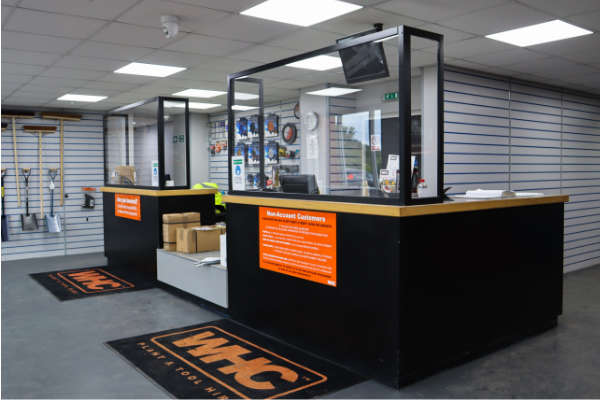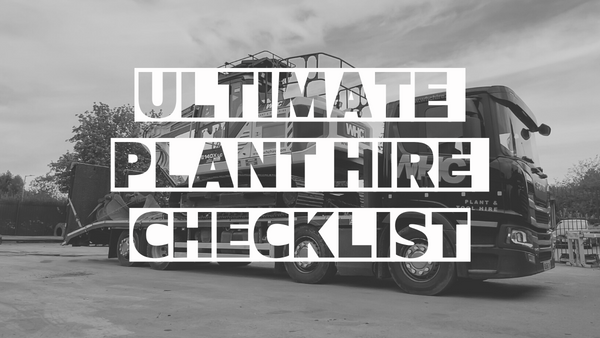The Ultimate Plant Hire Checklist
Hiring machinery can seem a bit of an alien thing to do for some. Having the correct tool for the job is essential to a safe, well-timed, completed project. No matter its size. Insufficient equipment has a dramatic impact on your overall productivity and wellbeing throughout a project. In this ultimate plant hire checklist, we are going to share with you the complete process of getting the equipment you need.
We will share with you the best ways to choose the right equipment, the process of delivery, how to avoid mistakes and give you the best chance of succession. This is based on our 25 years of supplying our own equipment to businesses of all sizes and the public. Therefore, following this guide will give you the best opportunity to maximise your productivity, lower your hire cost and remain safe whilst doing so.
Let’s begin with guiding you through the plant hire checklist.
The process of plant hire
Plant hire of the twenty-first century has come a long way with some much variety, quality and levels of economy available on the market. If you are not aware of what plant hire is, Collins’ dictionary explains a plant hire company as,
“a company that hires out mobile mechanical equipment for construction, road-making, etc,”
The complete process of getting equipment from a supplier is one that you shouldn’t find difficult. Sometimes, you can expect to have what you need in minutes of requesting it. Not sure how? It starts with finding the right equipment supplier.

Finding the right equipment supplier for you (plant hire checklist)
Finding the right plant hire supplier can be difficult. This means it can take time to find the right supplier, but it is essential to do so.
If you haven’t already checked it out, here is a free resource to help you vet out the right company.
Once you’ve vetted out your potential suppliers, it’s time to understand your equipment requirements. This could be for one specific task, or even a long-term project. Finding one supplier that can offer everything that you need will make the whole process of hiring plant equipment easier.
Understanding your budget
Budgeting is essential to be able to ensure that you are still making a profit. The beauty of hiring plant machinery is that you don’t have to pay for it immediately like you would if you purchased a machine.
Credit accounts are invoiced at agreed intervals to clear their balances, allowing time to gather funds before paying for the equipment. You can simply reference your hire to specific jobs to ensure you keep a healthy cash flow. You must always clear your account balance, failure to do so will directly affect applying for credit in the future.
If you are hiring plant machinery for recreational reasons or DIY projects, then you need to make sure you budget sufficiently. One way to get an idea of how long you might need a specific piece of equipment for, is to speak to your hire company. This will give you a better understanding much you should budget for hiring plant equipment.
Plant hire checklist to order equipment

Follow this plant hire checklist to help you order equipment efficiently.
- Which supplier you are going to use?
- What equipment you want?
- Where do you want the equipment?
- When do you want the equipment?
- How long do you want the machinery?
- Accessories?
- How are you going to pay?
Which supplier you are going to use?
Ensure you have a clear idea of the supplier you are going to use. Be sure that you vet them out correctly by understanding if they are the right match for you. Take your time and don’t be afraid to be picky of who you select. Remember your plant hire supplier can directly affect your reputation as a business.
What equipment you want?
Knowing the exact equipment that you need is essential to the whole process. If you need plant hire at short notice, you may have to compromise. Make sure that you book your equipment in plenty of time.
Where do you want the equipment?
Does the equipment need to be delivered to a specific location? Various plant hire equipment is too heavy to tow on a trailer behind a standard vehicle. Therefore, you may need to have it delivered. The more information you can provide about a delivery address, the better. We would recommend using either google maps or what three words to pinpoint your delivery location. For more information on delivery cost, check out “How Much Does It Cost To Deliver Plant Hire Equipment”.
When do you want the equipment?
Knowing when you want the equipment is essential for the whole process coming together. As previously mentioned, you should always book your equipment in plenty of time so it can arrive on time. Even though a lot of deliveries take place within 24hr notice, extra large machinery may require a movement notice to be submitted to highways UK beforehand. This is a legal requirement and can take time to approve.
How long do you want the machinery?
Understanding how long you want the machinery for is vital to staying within your budget. The best way to understand how long you will need equipment, is to refer to your operator’s method statement for the task. It is important that this highlights reason why you require the machinery in the first place. This could be to dig, move, or lift (X) amount. For example:
Dig up 100 tonnes of earth using a 3T Mini digger.
Calculate the cycle time (How long does one cycle take from digging in)
E.g.: Cycle time = 30s. Therefore in 60 mins, an excavator will produce 120 cycles. 120 cycles per hour.
Each bucket has a capacity of (X). Then times the bucket capacity by the number of cycles to find out how much bulk you can move in one hour. You should bare in mind that this would be based on being in one continuous place all day. You will need to factor in breaks, moving etc. We then add this back to our equation to calculate how many hours of digging are required.
100 tonnes of earth to move
@ 100kg per bucket. 2 buckets per minute (200kg per min), times 60 (12,000kg per hour) =
100,000kg (100 tonnes)/12,000kg per hour =8.3 hours digging required for.
The same calculation can be applied to any piece of plant equipment to figure out how long you may need the machinery for. If you are stuck, ask your supplier to help calculate.
Accessories?
Some plant hire equipment may require additional equipment to be able to use the machinery in the manner you wish to. This could be the addition of an attachment or an optional extra with your hire. There are many accessories that you might find with your chosen plant hire equipment. Therefore, it is important to understand the machine’s capabilities before adding any further cost to your bill.
How are you going to pay?
Understanding how you are going to pay is vital to even get your fingers on equipment. There are two methods of hiring plant machinery. Firstly by a credit account, which requires opening before ordering. Or alternatively, a cash-type account where a security deposit must be paid before the equipment is handed over to you. The size of the security deposits is down to the discretion of the supplier you are dealing with.
The process of off-hiring your equipment (plant hire checklist)

One of the most popular questions that we hear from customers is “how to off-hire your equipment?” The answer is that it totally depends on the supplier you are working with. Each plant hire supplier will have its own terms and conditions to break the contract agreement with them. This very important information which is found on the agreement that you sign on receipt of your equipment. If you are unsure, then you should speak to your supplier directly.
The most common ways to off-hire your equipment are:
- Return it directly to the depot you collected it from.
- Call your supplier to request off-hire
- Email your supplier
What happens after off hiring?
Once you off-hire, or requested the return of the machinery, you are no longer allowed to use it. Collection of the equipment tends to happen within 24hrs, sometimes sooner. It is best to keep all the components together to avoid any confusion during collection.
When returning the equipment yourself, simply drop by the depot you collected it from. What happens next? At this point, depending on what type of account you have with your partnering plant hire supplier the following will happen:
Cash customers- Once the equipment is returned, deposits are returned in full, minus the hire rate.
Account customers– Hire charge is added to an account to be invoiced monthly or quarterly depending on the supplier.
Refuelling rules with hiring equipment
If you have decided to hire plant equipment, then there will be no surprise that you are going to require some form fuel to use the machinery. Since April 2022, all operated plant hire equipment has now moved to use white diesel to correspond to the new laws on rebated diesel.
To avoid any additional charges, you should always refuel the machinery as instructed. Machinery returned with an empty full tank is charged. Machinery filled with incorrect fuel is charged for labour parts and fuel replacement. If you are ever unsure of the type of fuel or requirements you need to return your machinery in, then speak to your supplier.
Insurance checklist for hiring plant machinery
One of the most important things that you do when hiring any type of plant machinery, is to organise temporary insurance. This type of insurance covers you in the worst-case scenario that something goes wrong. The last thing that you need is a bill for more than £100,000 for damages caused. To help, we have put together a mini checklist to help you organise and understand the level of cover you may need.
Do you have public liability insurance?
If so, you still may not be insured for the use of rental equipment. Always check with your insurer. No matter the intended application for the equipment you should have sufficient cover for the machine. Temporary cover only takes 15 minutes to organise if necessary.
Enough cover?
Make sure you have adequate insurance to cover the bill in the worst-case scenario. Most temporary hire insurers will have explained to you the level of coverage that is provided with the premium you pay. If you are unsure of the level of coverage you need, you can speak to your plant hire supplier for more information. If you have insufficient cover, you must adjust your policy.
Starting your policy
Make sure that you agree to start your temporary hire policy the date the equipment comes into your possession. Be that via delivery or collection. Credit account customers must provide a full copy of their insurance before opening an account.
Understanding what your policy covers
Ensure you understand the policy you take out. Even though the terms and conditions of the insurance documents can be somewhat lengthy. It is essential make sure you are aware of the exclusions.
Choose a reputable hire company

For over 25 years, WHC Hire Services has built a wealthy reputation for its assistance of ensuring that every customer gets the right tool for the job. With a large fleet of excavators and high-performance plant hire equipment, we provide one of the safest and most productive fleets in the UK.
Whether you are looking for plant hire for a DIY project, or need a fleet of equipment to support your business in its projects. Feel free to view our online catalogue or call us on 01684377977 today.

